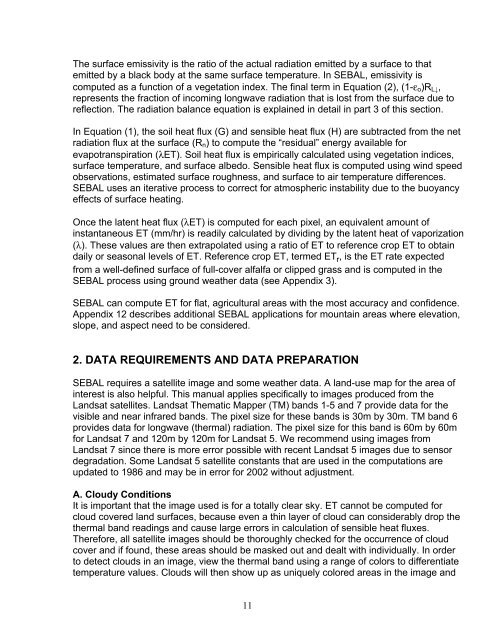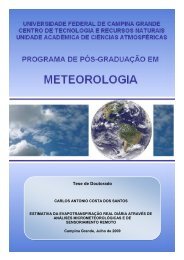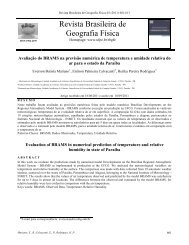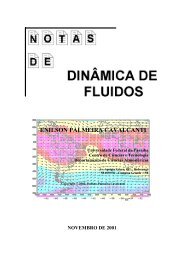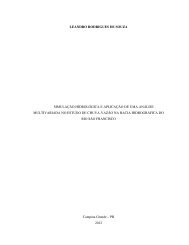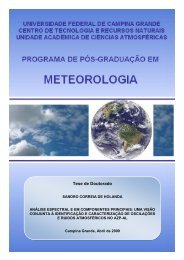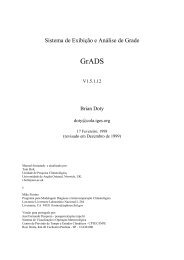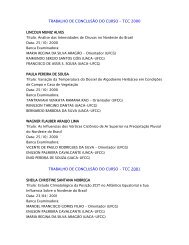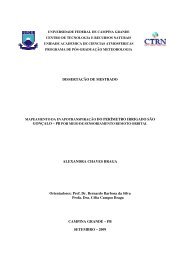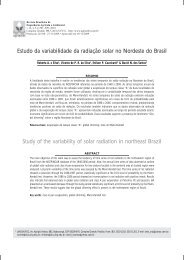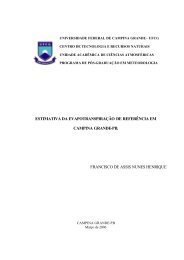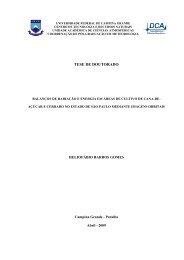You also want an ePaper? Increase the reach of your titles
YUMPU automatically turns print PDFs into web optimized ePapers that Google loves.
The surface emissivity is the ratio of the actual radiation emitted by a surface to thatemitted by a black body at the same surface temperature. In <strong>SEBAL</strong>, emissivity iscomputed as a function of a vegetation index. The final term in Equation (2), (1-ε o )R L↓ ,represents the fraction of incoming longwave radiation that is lost from the surface due toreflection. The radiation balance equation is explained in detail in part 3 of this section.In Equation (1), the soil heat flux (G) and sensible heat flux (H) are subtracted from the netradiation flux at the surface (R n ) to compute the “residual” energy available forevapotranspiration (λET). Soil heat flux is empirically calculated using vegetation indices,surface temperature, and surface albedo. Sensible heat flux is computed using wind speedobservations, estimated surface roughness, and surface to air temperature differences.<strong>SEBAL</strong> uses an iterative process to correct for atmospheric instability due to the buoyancyeffects of surface heating.Once the latent heat flux (λET) is computed for each pixel, an equivalent amount ofinstantaneous ET (mm/hr) is readily calculated by dividing by the latent heat of vaporization(λ). These values are then extrapolated using a ratio of ET to reference crop ET to obtaindaily or seasonal levels of ET. Reference crop ET, termed ET r , is the ET rate expectedfrom a well-defined surface of full-cover alfalfa or clipped grass and is computed in the<strong>SEBAL</strong> process using ground weather data (see Appendix 3).<strong>SEBAL</strong> can compute ET for flat, agricultural areas with the most accuracy and confidence.Appendix 12 describes additional <strong>SEBAL</strong> applications for mountain areas where elevation,slope, and aspect need to be considered.2. DATA REQUIREMENTS AND DATA PREPARATION<strong>SEBAL</strong> requires a satellite image and some weather data. A land-use map for the area ofinterest is also helpful. This manual applies specifically to images produced from theLandsat satellites. Landsat Thematic Mapper (TM) bands 1-5 and 7 provide data for thevisible and near infrared bands. The pixel size for these bands is 30m by 30m. TM band 6provides data for longwave (thermal) radiation. The pixel size for this band is 60m by 60mfor Landsat 7 and 120m by 120m for Landsat 5. We recommend using images fromLandsat 7 since there is more error possible with recent Landsat 5 images due to sensordegradation. Some Landsat 5 satellite constants that are used in the computations areupdated to 1986 and may be in error for 2002 without adjustment.A. Cloudy ConditionsIt is important that the image used is for a totally clear sky. ET cannot be computed forcloud covered land surfaces, because even a thin layer of cloud can considerably drop thethermal band readings and cause large errors in calculation of sensible heat fluxes.Therefore, all satellite images should be thoroughly checked for the occurrence of cloudcover and if found, these areas should be masked out and dealt with individually. In orderto detect clouds in an image, view the thermal band using a range of colors to differentiatetemperature values. Clouds will then show up as uniquely colored areas in the image and11


